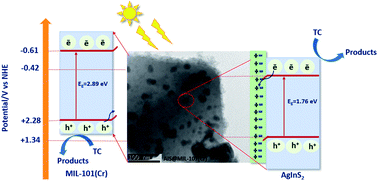Designing a novel heterostructure AgInS2@MIL-101(Cr) photocatalyst from PET plastic waste for tetracycline degradation
Abstract
Semiconductor-containing porous materials with a well-defined structure could be unique scaffolds for carrying out selective organic transformations driven by visible light. We herein introduce for the first time a heterostructure of silver indium sulfide (AgInS2) ternary chalcogenide and a highly porous MIL-101(Cr) metal–organic framework (MOF) synthesised from polyethylene terephthalate plastic waste. Our results demonstrate that AgInS2 nanoparticles were uniformly attached to each lattice plane of the octahedral MIL-101(Cr) structure, resulting in a nanocomposite with a high distribution of semiconductors in a porous media. We also demonstrate that the nanocomposite with up to 40% of AgInS2 doping exhibited excellent catalytic activity for tetracycline degradation under visible light irradiation (∼99% tetracycline degraded after 4 h) and predominantly maintained its performance after five cycles. These results could promote a new material circularity pathway to develop new semiconductors that can be used to protect water from further pollution.



 Please wait while we load your content...
Please wait while we load your content...